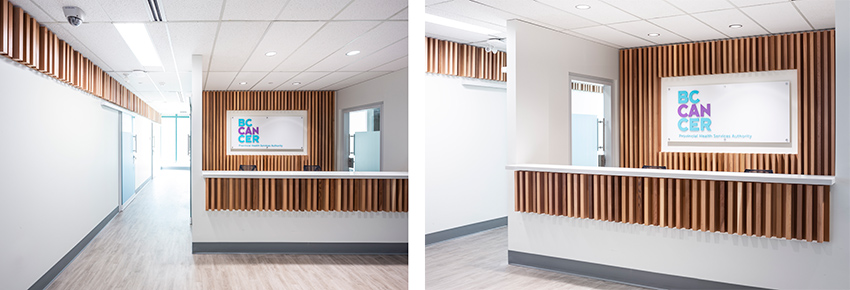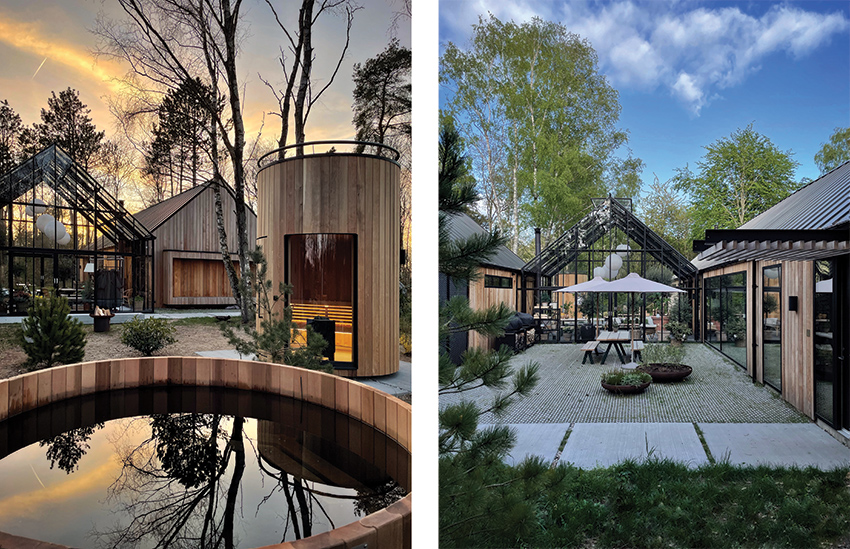Biophilic Design
Incorporating nature into the building can increase the sense of connectedness to the natural environment. This can be achieved with vegetation walls (internal/external), designs mimicking natural forms and patterns, and water features.
15 PATTERNS OF BIOPHILIC DESIGN13
Terrapin Bright Green, an environmental consulting and strategic planning firm, is the leading authority on biophilic design and notes that experiences of nature in the built environment tend to fall into three broad categories, which can be further broken down into 15 patterns of biophilic design. The three categories are Nature in the Space, Natural Analogues, and Nature of the Space. This is just a brief overview of the 15 patterns of biophilic design, which Terrapin leaves to the designer to interpret, but we will discuss specific patterns as they relate to wood a bit later in the course.
Nature in the Space
Nature in the Space refers to having direct, physical experiences with nature in the built environment. These can include views of landscapes, plant life, water, and animals, as well as breezes, sounds, scents, and other natural elements. Terrapin says, “The strongest Nature in the Space experiences are achieved through the creation of meaningful, direct connections with these natural elements, particularly through diversity, movement, and multi-sensory interactions.”
Nature in the Space encompasses seven biophilic design patterns:
- Visual Connection with Nature
- Non-Visual Connection with Nature
- Non-Rhythmic Sensory Stimuli
- Thermal & Airflow Variability
- Presence of Water
- Dynamic & Diffuse Light
- Connection with Natural Systems
Natural Analogues
Natural Analogues refers to indirect experiences of nature in the built environment. These include collinear (points in a straight line) and biomorphic forms, natural materials, and a level of complexity and order through materials or patterns, such as fractals. Terrapin says, “Objects, materials, colors, shapes, sequences, and patterns found in nature can manifest as artwork, ornamentation, furniture, décor, and textiles in the built environment. For example, mimicry of shells and leaves, furniture with organic shapes, and natural materials that have been processed or extensively altered (e.g., wood planks, granite tabletops), each provide an indirect connection with nature. While they are real, they are only analogous to the items in their ‘natural’ state.”
Natural Analogues encompasses three patterns of biophilic design:
- Biomorphic Forms & Patterns
- Material Connection with Nature
- Complexity & Order
Nature of the Space
Nature of the Space addresses spatial configurations in nature. This includes our innate and learned desire to be able to see beyond our immediate surroundings (distant views through a space); our fascination with the slightly dangerous or unknown; obscured views and revelatory moments; and sometimes even phobia inducing properties when they include a trusted element of safety. It should be noted that Pattern 15—Awe, was added in 2020 and is not included in Terrapin’s 14 Patterns of Biophilic Design, published in 2014.
Nature of the Space encompasses four biophilic design patterns:
- Prospect
- Refuge
- Mystery
- Risk/Peril
- Awe
Of the 15 patterns of biophilic design, wood falls most clearly into Biomorphic Forms and Patterns—Pattern #8 and Material Connection with Nature—Pattern #9.
Biophilia literally means a love of life or living things and is a personality trait initially described by Erich Fromm, and later E.O. Wilson. Both agree that “biophilia has a biological basis and it is fundamental to develop harmonious relationships between humans and nature.”1 Fromm used the term biophilia to “describe the psychological orientation of being attracted to all that is alive and vital,” while Wilson used the term biophilia to “describe the traits of evolutionary adaptation that allow us to develop a mental link with the living world and nature.”2
Edward O. Wilson ultimately popularized the biophilia hypothesis, which suggests that humans possess an innate tendency to seek connections with nature and other forms of life, in his book, Biophilia. In 1993, Wilson and colleague Stephen R. Kellert published the collection of essays The Biophilia Hypothesis, which claims that “the human dependence on nature extends far beyond the simple issues of material and physical sustenance to encompass as well the human craving for aesthetic, intellectual, cognitive, and even spiritual meaning and satisfaction.”3
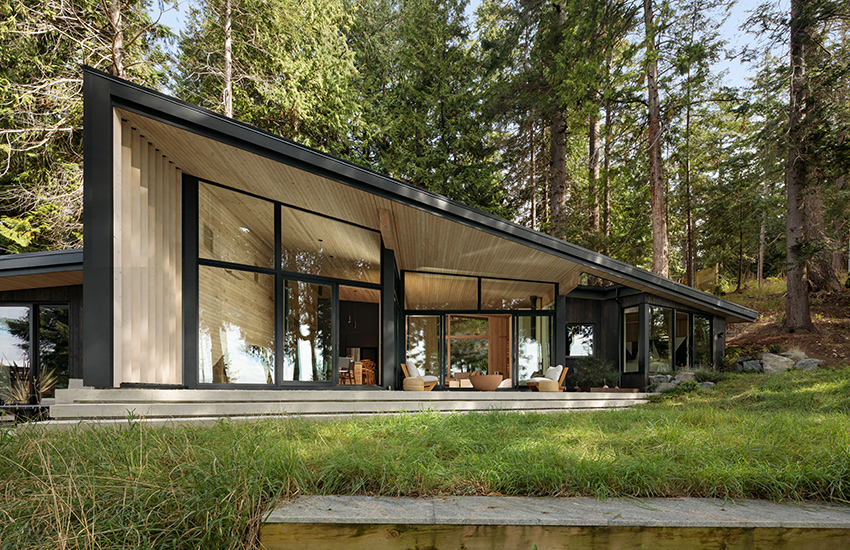
Photo courtesy of Ema Peter
Halfmoon Bay. Architect: Patrick Warren
INTRODUCTION TO BIOPHILIC DESIGN
Biophilic design is design that reconnects us to nature. Nature partially satisfies the psychological need to belong and relate, so activities that involve contact with nature have been shown to improve connectedness, well-being, and promote behavior that benefits the environment. Studies show that people tend to behave more altruistically in natural environments and have an increased sense of satisfaction with life. Conversely, disconnecting from nature has detrimental effects on both mental and physical health. Many studies observe that direct exposure to nature, even in brief increments, can offer visible psychophysiological benefits, but due to an increasingly urban lifestyle, our contact with nature has become less frequent. “Unfortunately, modern people, especially children, lack direct and frequent contact with nature and this can have negative consequences on their physical and mental health. Biophilic design, considering the evolutionary roots of this architectural approach, is an effective way of planning/designing interior and urban environments to stimulate the innate biophilia of the individual.”4
In 2007, the urban population surpassed the rural population for the first time in human history5 and the World Health Organization forecasts that 68% of the population will live in cities by 2050.6 Without intervention and careful design, people living in cities will have increasingly fewer opportunities to get in touch with nature, so it’s vitally important to create environments that stimulate biophilia as much as possible. Biophilic design can meet this need, with the goal being to create artificial environments as similar as possible to natural ones, to ensure people receive the positive effects of nature on their health and well-being.
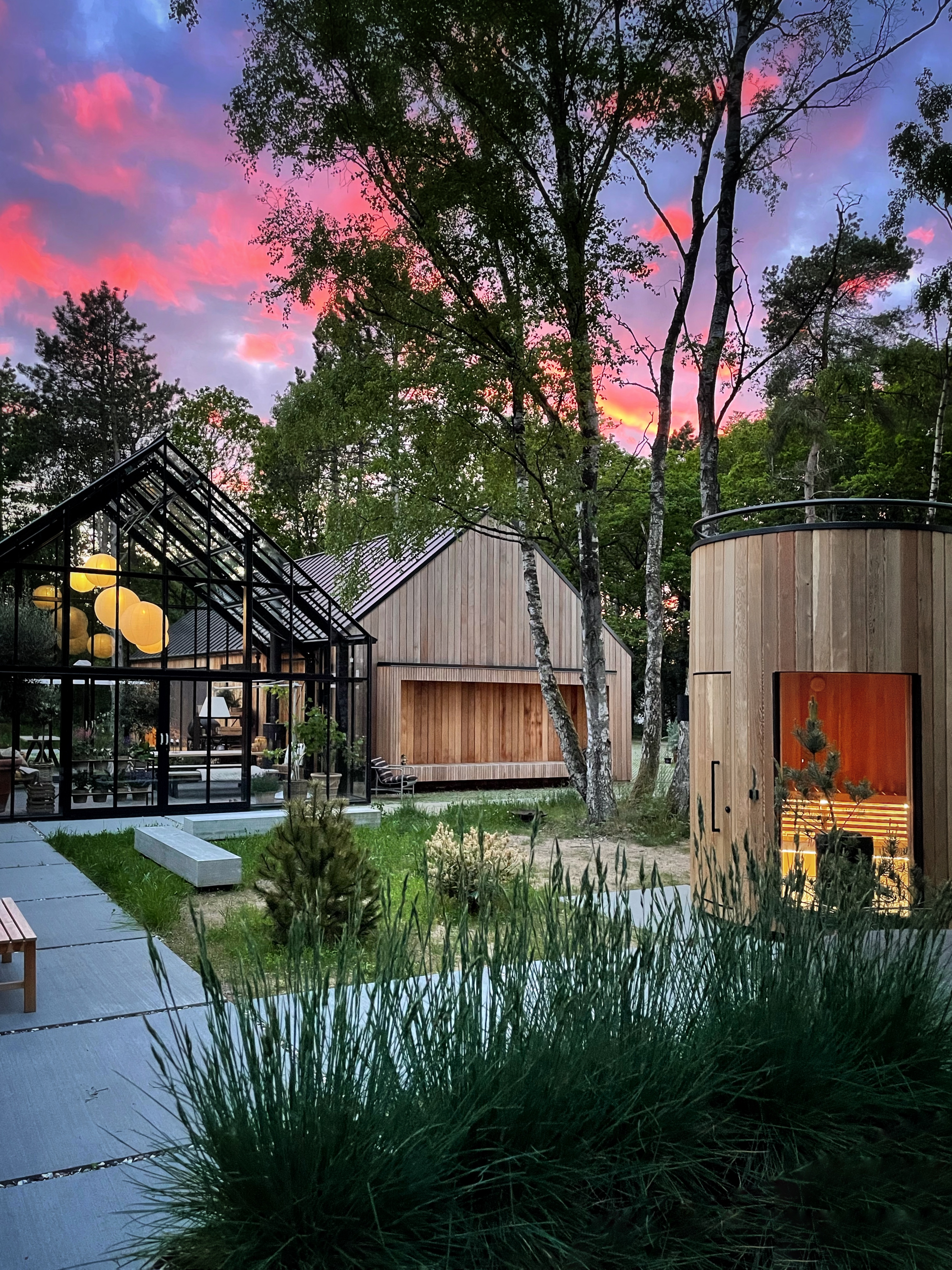
Photo courtesy of Bruno Jakobsen, Jakob Lerche
Nordic Barn. Architect: Bruno Jakobsen Design
PHYSICAL AND MENTAL BENEFITS OF BIOPHILIC DESIGN
Biophilic design has been shown to reduce stress, which lowers blood pressure and cortisol levels while promoting feelings of comfort and restfulness. It can also improve cognitive function and creativity, which is especially important for education and office settings. In fact, a study of 2,593 schoolchildren in Barcelona, Spain researched how exposure to green space affected the cognitive development of school children between the ages of 7 and 10. “This study, based on comprehensive characterization of outdoor surrounding greenness (at home, school, and during commuting) and repeated computerized cognitive tests in schoolchildren, found an improvement in cognitive development associated with surrounding greenness, particularly with greenness at schools.”7
Nature can also regulate emotion, mood, and visual preference for a space or goods. For example, in retail and hospitality settings, visual, tactile, and olfactory cues are important and can aid in branding and consumer experience if they are connected to nature. Experiences with nature, whether real or simulated, have also been shown to improve well-being and expedite healing. In healthcare, biophilic design can lead to shorter hospital stays, fewer negative comments, and fewer strong analgesics. As you can see, exposure to nature in the built environment is vitally important for the health, well-being, and cognitive functioning of building occupants, especially as the world population continues to urbanize. Architects and designers will play a key role in facilitating this connection to the natural world through biophilic design.
BIOPHILIC QUALITY INDEX
Until recently, “green” architecture, or sustainable design, has focused on the energy performance of buildings and their impact on the environment but doesn’t consider how incorporating natural elements into building design could impact occupants. “Sustainability does not really push architects to go beyond form and scale design to encompass the well-being and quality of life of users, which should be among the most important architectural considerations today.”8 But this is changing with more recent programs such as The WELL Building Standard and The Living Building Challenge that take a more holistic view of sustainable design and its impact on occupant health and well-being. In their publication The Biophilic Quality Index: A Tool to Improve a Building from “Green” to Restorative, the authors discuss a reliable instrument they have developed that can be used to calculate to what extent a building is biophilic. They call it the Biophilic Quality Index (BQI) and posit that to achieve a balance between sustainability and biophilia, a paradigm shift from “green” to “restorative” is needed to really accomplish biophilic design. “The BQI can be used both as a guide to follow for a building-to-be and as a rating system for an existing building, where the final score (a percentage) represents the room for improvement. The BQI will help architects integrate nature in design and promote the understanding that to plan restorative environments is not only an aesthetic need but a necessity for human being’s efficient cognitive functioning.”9
GROWTH OF THE “WELLNESS REAL ESTATE” MARKET
Beyond professionals in the architectural community who have been moving toward a holistic view of sustainability and wellness in building design, consumers are increasingly aware of how their lifestyle and external environmental factors impact their health and well-being. They are seeking solutions to enhance their health and wellness and are looking directly to the real estate industry to align with these expectations. According to the Global Wellness Institute (GWI), wellness real estate is defined as “the construction of residential and commercial/institutional (i.e., office, hospitality, mixed-use/multi-family, medical, leisure, etc.) properties that incorporate intentional wellness elements in their design, materials, buildings, amenities, services, and/or programming.” Wellness real estate now represents a key industry within the global economy and was a $275 billion industry in 2020.10
Boston University’s School of Hospitality Administration notes, “It can be anticipated that such developments will likely become the norm, progressively transforming residential neighborhoods and cities. Such a transformation would benefit populations and the environment and result in higher profitability and returns for all stakeholders. Although wellness real estate represents a small portion of the real estate industry, the benefits it brings are expected to generate a rising interest from stakeholders globally.”11
Important design details for wellness real estate in individual facilities are orientation and form; materials; and biophilic design.12
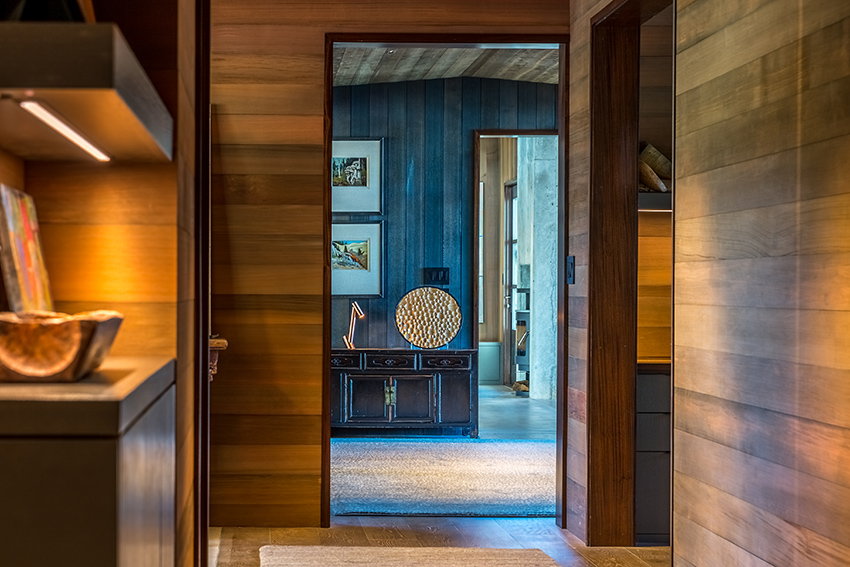
Photo courtesy of Anna Spencer
Kayak Point. Architect: Christopher Wright Architecture
Orientation and Form
This entails positioning and designing the form of the buildings to maximize the use of environmental resources (e.g., light, air, views, cross-ventilation) to create comfort and optimize energy consumption.
Materials
It’s important to prioritize natural, durable, and functional materials requiring minimal maintenance to create a sense of warmth with surfaces that are soft to the touch. To limit the carbon footprint, these materials should be locally sourced. Such materials include natural stones, wood, and textured tiles and should naturally blend with the shapes and tones of the local landscape.
Wood is one such material that is natural, durable, and functional and requires minimal maintenance, particularly when used in interiors. Bill Browning of Terrapin Brightgreen, when interviewed in the Biophilic Solutions podcast, notes that wood has the ability to patina with age versus wear down, necessitating less frequent replacement. This is important for project types such as hospitality, which typically replace furnishings on a seven-year rotation.
Biophilic Design
Incorporating nature into the building can increase the sense of connectedness to the natural environment. This can be achieved with vegetation walls (internal/external), designs mimicking natural forms and patterns, and water features.
15 PATTERNS OF BIOPHILIC DESIGN13
Terrapin Bright Green, an environmental consulting and strategic planning firm, is the leading authority on biophilic design and notes that experiences of nature in the built environment tend to fall into three broad categories, which can be further broken down into 15 patterns of biophilic design. The three categories are Nature in the Space, Natural Analogues, and Nature of the Space. This is just a brief overview of the 15 patterns of biophilic design, which Terrapin leaves to the designer to interpret, but we will discuss specific patterns as they relate to wood a bit later in the course.
Nature in the Space
Nature in the Space refers to having direct, physical experiences with nature in the built environment. These can include views of landscapes, plant life, water, and animals, as well as breezes, sounds, scents, and other natural elements. Terrapin says, “The strongest Nature in the Space experiences are achieved through the creation of meaningful, direct connections with these natural elements, particularly through diversity, movement, and multi-sensory interactions.”
Nature in the Space encompasses seven biophilic design patterns:
- Visual Connection with Nature
- Non-Visual Connection with Nature
- Non-Rhythmic Sensory Stimuli
- Thermal & Airflow Variability
- Presence of Water
- Dynamic & Diffuse Light
- Connection with Natural Systems
Natural Analogues
Natural Analogues refers to indirect experiences of nature in the built environment. These include collinear (points in a straight line) and biomorphic forms, natural materials, and a level of complexity and order through materials or patterns, such as fractals. Terrapin says, “Objects, materials, colors, shapes, sequences, and patterns found in nature can manifest as artwork, ornamentation, furniture, décor, and textiles in the built environment. For example, mimicry of shells and leaves, furniture with organic shapes, and natural materials that have been processed or extensively altered (e.g., wood planks, granite tabletops), each provide an indirect connection with nature. While they are real, they are only analogous to the items in their ‘natural’ state.”
Natural Analogues encompasses three patterns of biophilic design:
- Biomorphic Forms & Patterns
- Material Connection with Nature
- Complexity & Order
Nature of the Space
Nature of the Space addresses spatial configurations in nature. This includes our innate and learned desire to be able to see beyond our immediate surroundings (distant views through a space); our fascination with the slightly dangerous or unknown; obscured views and revelatory moments; and sometimes even phobia inducing properties when they include a trusted element of safety. It should be noted that Pattern 15—Awe, was added in 2020 and is not included in Terrapin’s 14 Patterns of Biophilic Design, published in 2014.
Nature of the Space encompasses four biophilic design patterns:
- Prospect
- Refuge
- Mystery
- Risk/Peril
- Awe
Of the 15 patterns of biophilic design, wood falls most clearly into Biomorphic Forms and Patterns—Pattern #8 and Material Connection with Nature—Pattern #9.
BIOPHILIC RESPONSES TO WOOD
According to Terrapin Bright Green’s 2022 publication, The Nature of Wood – An Exploration of the Science on Biophilic Responses to Wood, “Designing elements of nature into the built environment can have health benefits including stress reduction, improved cognitive performance, enhanced moods, and increased preference for spaces. These benefits are often referred to as ‘biophilic responses’ and we have a particularly strong biophilic response to wood, more than almost any other material.” These biophilic responses include the haptic response, olfactory experience, and visual experience. Wood can also have a thermal response on the body and sound absorption qualities that can make a space more pleasant to inhabit, but there have been fewer studies about these biophilic responses to wood.

Photo courtesy of Brit Kwasney
Wii Gyemsiga. Architect: hcma
Haptic Response
The haptic response, or our sense of touch, is elicited by the tactile feel of wood. In a blindfolded experiment that aimed to clarify the physiological effects of touching wood with the palm, in comparison with touching other materials on brain activity and autonomic nervous activity, participants placed their palms on a panel of stainless steel, tile, marble, or white oak. Touching the oak panel led to increases in activity of the parasympathetic (rest and calming) portion of the nervous system that did not occur with the other materials. The study says, “These results may be due to wood having lower thermal conductance than metal or stone, and therefore feels closer to the perceived ambient temperature of a space.”
Olfactory Experience
Smell has a way of quickly and powerfully eliciting memories and a physiological response to these olfactory experiences. The natural smell of cedar and other woods can elicit a biophilic response that is calming and triggers neuropathways similar to antianxiety drugs. It can also level blood pressure and heart rate. For example, a study of the respiratory response and heart rate among participants who slept in a bed made of fragrant stone pine showed significant physiological improvements compared to those in a bed made of chipboard covered in melamine. The researchers attributed this outcome to the conifer resins, including limonene.15 It should be noted that the natural scent of wood will dissipate over time, so the olfactory experience should not be heavily relied upon in biophilic design.
Visual Experience
Most of the research on our biophilic responses to wood centers around the visual experience. Nature-made and human-made objects and environments are processed differently in the brain, with humans typically preferring the former. The brain visually identifies and processes images by association, subconsciously separating things as living or non-living. Terrapin Bright Green says, “While wooden objects are crafted by humans—a process that is often considered manufactured or unnatural—the wood itself is still considered to be ‘natural,’ which may hint at why research suggests we like having wood around us in buildings. Wood has been used in the construction of shelters and artifacts for thousands of years in cultures around the world. It historically has been a plentiful resource that is readily shaped by simple tools.”16
The visual presence of wood in a room leads to perceptions of warmth and comfort, which lowers blood pressure levels and heart rates and activates the parasympathetic nervous system, which restores the body to a calm and composed state. People visually identify natural objects by their surface characteristics, which, for wood, include color, grooves, knots, and grain. Regarding color, people tend to prefer untreated wood in the red-to-yellow spectrum, which evokes warm feelings and calm. Think of western red cedar. The Nature of Wood states, “When the brain looks at wood, it is (almost) instantaneously identifying the curves of the wood grain and surface appearance to determine the type of material. Whether the object is a chair, guitar, spatula, beam, or sheet of plywood, it is identified as wood by the patterns on the surface.”
Collinear, contour, curvilinear, parallel, and radial patterns are ubiquitous in nature, so when people see these recognizable patterns in the built environment it makes visual processing easier. Likewise, fractals are layered self-repeating mathematical patterns that occur frequently in nature (e.g., snowflakes, fern leaves, waves, and dappled light from a tree canopy) and create a biophilic response when viewed. They are so common in nature that when we see fractal patterns, even in man-made objects, it is easy for the brain to process the image and measurably lowers our stress level. This is called fractal fluency.17
People have a visual preference for patterns with mid-range complexity, which can elicit restoration and relaxation. But highly complex patterns cause stress. Similarly, lines running in the same direction are easier to process, while lines running in multiple directions take more effort. “The brain will follow curvatures and contours, and even connect short segments of lines to discern a longer curving pattern. These pattern conditions occur frequently in nature and our brains, it could be argued, are predisposed to easily decipher them.”18 In the built environment, wood grain that features collinear lines and nested fractal patterns (layered oval shapes in the wood grain) is easy to process and therefore desirable, making it a strong driver of biophilic design. Because we see these patterns so often in nature, they elicit a response when we see them in wood.
Why Use Western Red Cedar in Biophilic Design?
Western red cedar is an optimal wood species choice for biophilic design. The wood’s rich tonal range and beautifully pronounced grain immediately connect people to nature. It’s also a top-performing building material that will enhance the well-being of occupants for decades to come. Western red cedar comes in a wide range of sizes, grades, and profiles, which gives design teams flexibility in creating their desired look.
DESIGN CONSIDERATIONS FOR USING WOOD IN THE BUILT ENVIRONMENT
Wood provides warmth and richness that contrasts well with more modern materials such as concrete, steel, and glass. When using wood in the built environment, it’s key to prioritize the wood grain and contour lines by making them readily visible rather than hiding the grain with paint or a stain that is so dark that it hides the grain. The number of grooves and knots is also an important consideration. The look of knotty cedar may be desired, as it adds texture and contrast, enhancing the symbiotic dynamic between a home’s interior and exterior. Occasional knots do not distract from the contour lines, but too many knots can “negate the stress reduction characteristics of the collinear and contoured patterns in wood.”19
It’s also important to consider the amount of wood used in a space. Too much wood can have a negative effect on physiology and psychology, while too little won’t elicit a response.
The number of building products on the market today that attempt to simulate the color, grain, and texture of wood is astounding, but synthetic wood products don’t hold a candle to real wood. Wood creates an immediate and seamless connection to natural surroundings that no synthetic wood can replicate. This is because wood was alive and has a cellular structure that is present even after harvesting. Light bounces off those cells, giving wood a reflective quality that is unique to the material. “This can make both the grain pattern and surface color appear to change. Fake wood does not have a cellular structure and thus far cannot replicate this visual experience.”20 Nature still knows best—despite all efforts at imitation, no man-made product can match the beauty, performance, and longevity of western red cedar.
A NOTE ABOUT FINISHING WOOD
To maximize the biophilic effect of wood it’s ideal to maintain the rich beauty of western red cedar’s natural color versus finishing with an opaque coating such as solid stain or paint. This natural color can be enhanced or modified by applying any number of commercial finishes such as transparent or semi-transparent stains. If left in its natural state, some darkening or graying of the wood can be expected as it ages and the color variation will become less pronounced. Western red cedar is pitch and resin-free, so it takes stains and oils very well. What’s more, there are some stunning new ways to finish western red cedar now on the market. Products like bleaching stains and weathering products create the gorgeous silvery gray look of aged cedar and provide water repellency.
Exterior Finishes
Transparent and semi-transparent stains let the incredible natural luster of the wood shine through and highlight the grain. Sometimes referred to as water-repellant preservatives, transparent stains do not alter the appearance of the cedar because they only slightly modify the color (tone) of the wood. Transparent stains are similar in composition to semi-transparent stains, but they contain fewer or no pigments. Solvent-borne semi-transparent stains contain pigments that provide color, including cedar tones, and greatly increase the durability of the finish by partially protecting the cedar surface from the damaging effects of the sun’s ultraviolet rays.
Interior Finishes
For interior cedar applications, most homeowners simply want to retain and enhance the wood’s natural appearance. This is best achieved using transparent finishes such as waxes, Danish oils, non-yellowing plastic, and other clear finishes that provide some protection to the cedar from minor abrasion and liquids. Western red cedar used indoors can also be coated with a variety of finishes such as bleach, oils, semi-transparent and solid body stains, and opaque finishes but as we noted with exterior finishes, the latter two will hide the natural wood color.

Photo courtesy of Bruno Jakobsen, Jakob Lerche
Nordic Barn. Architect: Bruno Jakobsen Design
Interior Applications
Wood and other elements of nature can be incorporated into any type of residential, commercial, or institutional project to bring nature indoors and promote well-being, reduce stress, and improve mental health for occupants. An increasing number of architects and their clients are starting to appreciate cedar’s stunning appearance and ability to beautify interior spaces. Western red cedar introduces warm, natural beauty into interiors and will last the lifetime of the building if cared for properly. Bringing cedar inside is the best way to add visual appeal and create a greater connection to nature. There are myriad interior uses, from ceilings and soffits to features walls, wood paneling, exposed posts and beams, louvers, furniture, and cabinets.
As for ceilings and soffits, western red cedar paneling is a showstopper that works well in both contemporary and traditional homes, especially when it’s fanned out in a natural range of colors. Cedar beams with a hint of wrought iron can infuse an urban edge, while cedar soffits can carry from the exterior to the interior for a look that connects the indoors to the outside. Whether it’s just one dramatic feature wall in a strikingly modern setting or an entire room with rustic charm, tongue-and-groove paneling, feature walls, and room dividers will elevate the beauty and vivacity of the space. Like all cedar products, tongue-and-groove is incredibly versatile. For example, you can specify tongue-and-groove paneling with a rough face for a more textured look or smooth face for a more polished look. The pieces can be joined with V-shaped, flush, reveal, or radial joinery, and the desired shadowing effect can be achieved by combining one of these joinery techniques with select surface textures.
Exterior Applications
While it might not have quite the dramatic biophilic response as interior applications, there are many reasons to use wood on the exterior of buildings for siding, trim, soffits, decking, as well as cedar shingles and hand-split shakes. Western red cedar siding provides a wealth of options to provide the perfect look for a building, as it can be finished to complement all styles of architecture from modern to traditional to rustic. It comes in both clear and knotty grades, a variety of surface textures, and a spectrum of profiles and patterns, which can create very different styles for a home or building. These profiles can be installed vertically or horizontally and will create different shadow and line effects once on the wall.
End Notes
1,2“https://www.frontiersin.org/articles/10.3389/fpsyg.2021.700709/full”
3Kellert and Edward O. Wilson. The Biophilia Hypothesis. Washington, D.C. :Island Press, 1993.
4Barbiero Giuseppe, Berto Rita. Biophilia as Evolutionary Adaptation: An Onto- and Phylogenetic Framework for Biophilic Design. Frontiers in Psychology. Volume 12. 2021
5“https://www.worldbank.org/en/news/feature/2007/07/11/more-than-half-the-world-is-now-urban-un-report-says”
6“https://www.who.int/health-topics/urban-health#tab=tab_1”
7“https://doi.org/10.1016/j.envpol.2023.122143”
8,9“https://www.univda.it/wp-content/uploads/2018/11/2017-VfS-8-38-45-BQI.pdf”
10“https://globalwellnessinstitute.org/what-is-wellness/what-is-the-wellness-economy”
11,12“https://www.bu.edu/bhr/2022/03/29/a-guide-to-developing-wellness-real-estate”
13“http://www.terrapinbrightgreen.com/wp-content/uploads/2014/04/14-Patterns-of-Biophilic-Design-Terrapin-2014e.pdf”
14Ikei H, Song C, Miyazaki Y. Physiological Effects of Touching Wood. Int J Environ Res Public Health. 2017 Jul 18;14(7):801. doi: 10.3390/ijerph14070801. PMID: 28718814; PMCID: PMC5551239.
15“https://www.ncbi.nlm.nih.gov/pmc/articles/PMC8472742/”
16,17,18,19“http://www.terrapinbrightgreen.com/wp-content/uploads/2022/01/The-Nature-of-Wood_Terrapin_2022-01.pdf”
20“https://www.cs.cornell.edu/~srm/publications/SG05-wood.html”
21“https://www.realcedar.com/blog/biophilic-design-in-healthcare/”

